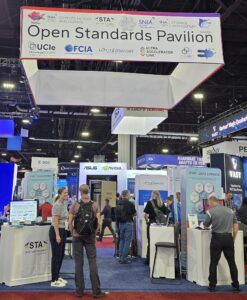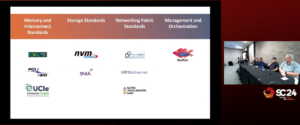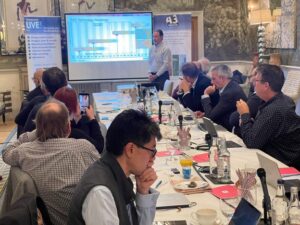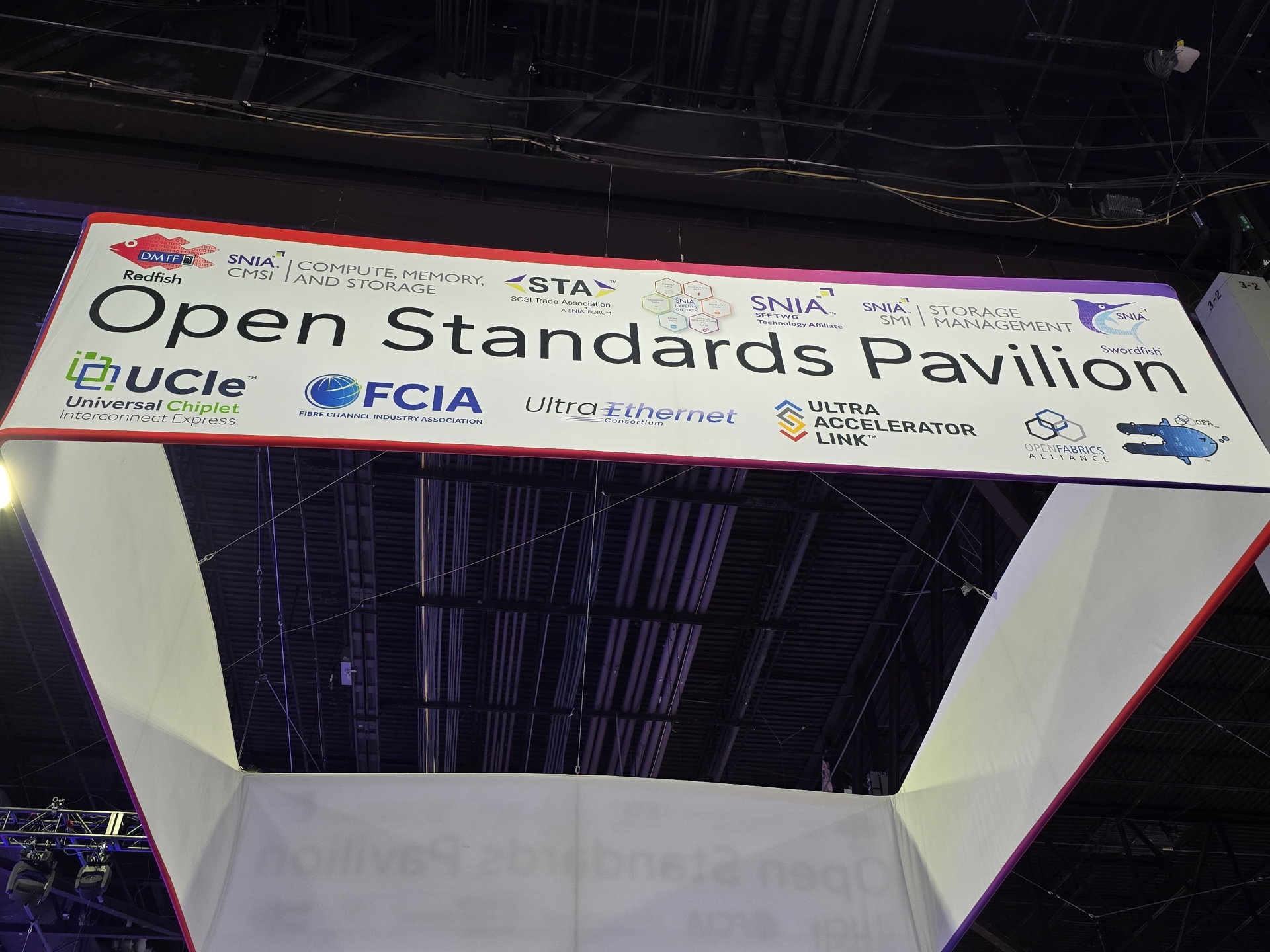November 2024 was a memorable month to engage with audiences at The International Conference for High Performance Computing, Networking, Storage, and Analysis (SC) 24 and Technology Live! to provide the latest on collaborative standards development and discuss high performance computing, artificial intelligence, and the future of storage.
At SC24, seven industry consortiums participated in an Open Standards Pavilion to discuss their joint activities in memory and interconnect standards, storage standards, networking fabric standards, and management and orchestration. Technology leaders from DMTF, Fibre Channel Industry Association, OpenFabrics Alliance, SNIA, Ultra Accelerator Link Consortium, Ultra Ethernet Consortium, and Universal Chiplet Interconnect Express™ Consortium shared how these standards are collaborating to foster innovation as technology trends accelerate. CXL® Consortium, NVM Express®, and PCI-SIG® joined these groups in a lively panel discussion moderated by Richelle Ahlvers, Vice Chair SNIA Board of Directors, on their cooperation in standards development.
Technology leaders from DMTF, Fibre Channel Industry Association, OpenFabrics Alliance, SNIA, Ultra Accelerator Link Consortium, Ultra Ethernet Consortium, and Universal Chiplet Interconnect Express™ Consortium shared how these standards are collaborating to foster innovation as technology trends accelerate. CXL® Consortium, NVM Express®, and PCI-SIG® joined these groups in a lively panel discussion moderated by Richelle Ahlvers, Vice Chair SNIA Board of Directors, on their cooperation in standards development.
 With the acceleration of AI and HPC technologies, industry standards bodies are essential to guarantee interoperability and facilitate faster deployment. Collaboration among industry standards groups fosters the development and deployment of advanced HPC solutions, driving innovation, collaboration, and efficiency. Joint activities from these industry associations include memory and interconnect standards, storage standards, networking fabric standards, and management and orchestration.
During SC24, SNIA engaged with analysts, partners, member companies, manufacturers, and end users to provide updates on their latest technical activities. SNIA Compute, Memory, and Storage Initiative discussed computational storage work from SNIA and NVM Express and new opportunities for audiences interested in CXL to program CXL memory modules in the SNIA Innovation Lab. SNIA Swordfish® discussed their collaboration with DMTF Redfish, OFA Sunfish, NVMe, and CXL on a unified approach to open storage management. SNIA SFF Technology Affiliate presented their technical releases in SSD E1, E3, U.2 and M.2 form factor standards. The SNIA STA Forum showcased 24G SAS products highlighting the technology's cutting-edge capabilities, discussing the benefits of SAS for high-performance computing environments and SAS's critical role in delivering reliability, scalability, and performance for modern data-driven applications. Check out our post-event video on LinkedIn!
At Technology Live! in London, the SNIA STA Forum shared insights with editors, analysts and influencers on the future of storage.
[caption id="attachment_3945" align="alignleft" width="300"]
With the acceleration of AI and HPC technologies, industry standards bodies are essential to guarantee interoperability and facilitate faster deployment. Collaboration among industry standards groups fosters the development and deployment of advanced HPC solutions, driving innovation, collaboration, and efficiency. Joint activities from these industry associations include memory and interconnect standards, storage standards, networking fabric standards, and management and orchestration.
During SC24, SNIA engaged with analysts, partners, member companies, manufacturers, and end users to provide updates on their latest technical activities. SNIA Compute, Memory, and Storage Initiative discussed computational storage work from SNIA and NVM Express and new opportunities for audiences interested in CXL to program CXL memory modules in the SNIA Innovation Lab. SNIA Swordfish® discussed their collaboration with DMTF Redfish, OFA Sunfish, NVMe, and CXL on a unified approach to open storage management. SNIA SFF Technology Affiliate presented their technical releases in SSD E1, E3, U.2 and M.2 form factor standards. The SNIA STA Forum showcased 24G SAS products highlighting the technology's cutting-edge capabilities, discussing the benefits of SAS for high-performance computing environments and SAS's critical role in delivering reliability, scalability, and performance for modern data-driven applications. Check out our post-event video on LinkedIn!
At Technology Live! in London, the SNIA STA Forum shared insights with editors, analysts and influencers on the future of storage.
[caption id="attachment_3945" align="alignleft" width="300"] Photo Credit: A3 Communications[/caption]
STA Chair Cameron T. Brett attended the event to represent SNIA, fostering an informed and balanced conversation within the industry. Later in the day, he delivered a comprehensive update on the latest advancements in SAS technology, including 24G+ SAS developments, recent tech enhancements, and the updated SAS Roadmap.
His presentation also highlighted new market data, and explored innovative applications such as SAS in space. A lively discussion around AI and its transformative impact on storage further demonstrated SAS's ability to meet the demands of emerging technologies. These conversations reinforced SAS's vital role in shaping next-generation data infrastructures. Watch the YouTube video of Cameron Brett’s SAS Presentation.
Looking forward to even more engagements in 2025! If you have not already, subscribe to SNIA Matters for the latest on ongoing SNIA activities and events!
Photo Credit: A3 Communications[/caption]
STA Chair Cameron T. Brett attended the event to represent SNIA, fostering an informed and balanced conversation within the industry. Later in the day, he delivered a comprehensive update on the latest advancements in SAS technology, including 24G+ SAS developments, recent tech enhancements, and the updated SAS Roadmap.
His presentation also highlighted new market data, and explored innovative applications such as SAS in space. A lively discussion around AI and its transformative impact on storage further demonstrated SAS's ability to meet the demands of emerging technologies. These conversations reinforced SAS's vital role in shaping next-generation data infrastructures. Watch the YouTube video of Cameron Brett’s SAS Presentation.
Looking forward to even more engagements in 2025! If you have not already, subscribe to SNIA Matters for the latest on ongoing SNIA activities and events!
 Technology leaders from DMTF, Fibre Channel Industry Association, OpenFabrics Alliance, SNIA, Ultra Accelerator Link Consortium, Ultra Ethernet Consortium, and Universal Chiplet Interconnect Express™ Consortium shared how these standards are collaborating to foster innovation as technology trends accelerate. CXL® Consortium, NVM Express®, and PCI-SIG® joined these groups in a lively panel discussion moderated by Richelle Ahlvers, Vice Chair SNIA Board of Directors, on their cooperation in standards development.
Technology leaders from DMTF, Fibre Channel Industry Association, OpenFabrics Alliance, SNIA, Ultra Accelerator Link Consortium, Ultra Ethernet Consortium, and Universal Chiplet Interconnect Express™ Consortium shared how these standards are collaborating to foster innovation as technology trends accelerate. CXL® Consortium, NVM Express®, and PCI-SIG® joined these groups in a lively panel discussion moderated by Richelle Ahlvers, Vice Chair SNIA Board of Directors, on their cooperation in standards development.
 With the acceleration of AI and HPC technologies, industry standards bodies are essential to guarantee interoperability and facilitate faster deployment. Collaboration among industry standards groups fosters the development and deployment of advanced HPC solutions, driving innovation, collaboration, and efficiency. Joint activities from these industry associations include memory and interconnect standards, storage standards, networking fabric standards, and management and orchestration.
During SC24, SNIA engaged with analysts, partners, member companies, manufacturers, and end users to provide updates on their latest technical activities. SNIA Compute, Memory, and Storage Initiative discussed computational storage work from SNIA and NVM Express and new opportunities for audiences interested in CXL to program CXL memory modules in the SNIA Innovation Lab. SNIA Swordfish® discussed their collaboration with DMTF Redfish, OFA Sunfish, NVMe, and CXL on a unified approach to open storage management. SNIA SFF Technology Affiliate presented their technical releases in SSD E1, E3, U.2 and M.2 form factor standards. The SNIA STA Forum showcased 24G SAS products highlighting the technology's cutting-edge capabilities, discussing the benefits of SAS for high-performance computing environments and SAS's critical role in delivering reliability, scalability, and performance for modern data-driven applications. Check out our post-event video on LinkedIn!
At Technology Live! in London, the SNIA STA Forum shared insights with editors, analysts and influencers on the future of storage.
[caption id="attachment_3945" align="alignleft" width="300"]
With the acceleration of AI and HPC technologies, industry standards bodies are essential to guarantee interoperability and facilitate faster deployment. Collaboration among industry standards groups fosters the development and deployment of advanced HPC solutions, driving innovation, collaboration, and efficiency. Joint activities from these industry associations include memory and interconnect standards, storage standards, networking fabric standards, and management and orchestration.
During SC24, SNIA engaged with analysts, partners, member companies, manufacturers, and end users to provide updates on their latest technical activities. SNIA Compute, Memory, and Storage Initiative discussed computational storage work from SNIA and NVM Express and new opportunities for audiences interested in CXL to program CXL memory modules in the SNIA Innovation Lab. SNIA Swordfish® discussed their collaboration with DMTF Redfish, OFA Sunfish, NVMe, and CXL on a unified approach to open storage management. SNIA SFF Technology Affiliate presented their technical releases in SSD E1, E3, U.2 and M.2 form factor standards. The SNIA STA Forum showcased 24G SAS products highlighting the technology's cutting-edge capabilities, discussing the benefits of SAS for high-performance computing environments and SAS's critical role in delivering reliability, scalability, and performance for modern data-driven applications. Check out our post-event video on LinkedIn!
At Technology Live! in London, the SNIA STA Forum shared insights with editors, analysts and influencers on the future of storage.
[caption id="attachment_3945" align="alignleft" width="300"] Photo Credit: A3 Communications[/caption]
STA Chair Cameron T. Brett attended the event to represent SNIA, fostering an informed and balanced conversation within the industry. Later in the day, he delivered a comprehensive update on the latest advancements in SAS technology, including 24G+ SAS developments, recent tech enhancements, and the updated SAS Roadmap.
His presentation also highlighted new market data, and explored innovative applications such as SAS in space. A lively discussion around AI and its transformative impact on storage further demonstrated SAS's ability to meet the demands of emerging technologies. These conversations reinforced SAS's vital role in shaping next-generation data infrastructures. Watch the YouTube video of Cameron Brett’s SAS Presentation.
Looking forward to even more engagements in 2025! If you have not already, subscribe to SNIA Matters for the latest on ongoing SNIA activities and events!
Photo Credit: A3 Communications[/caption]
STA Chair Cameron T. Brett attended the event to represent SNIA, fostering an informed and balanced conversation within the industry. Later in the day, he delivered a comprehensive update on the latest advancements in SAS technology, including 24G+ SAS developments, recent tech enhancements, and the updated SAS Roadmap.
His presentation also highlighted new market data, and explored innovative applications such as SAS in space. A lively discussion around AI and its transformative impact on storage further demonstrated SAS's ability to meet the demands of emerging technologies. These conversations reinforced SAS's vital role in shaping next-generation data infrastructures. Watch the YouTube video of Cameron Brett’s SAS Presentation.
Looking forward to even more engagements in 2025! If you have not already, subscribe to SNIA Matters for the latest on ongoing SNIA activities and events!









Leave a Reply